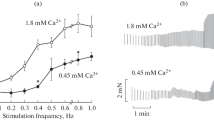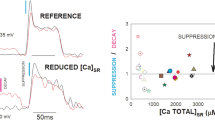Summary
The membrane of single crayfish muscle fibres was depolarized to −50 to zero mV for 50 or 500 ms by a voltage clamp through two microelectrodes. Simultaneously, clamp current, isometric force development and its first time derivative were recorded. After the depolarization pulse, the membrane potential was either clamped back to the holding potential of about −70 mV (“repolarization”), or clamped to a more negative potential of −95 to −125 mV (“hyperpolarization”). During such hyperpolarizations, relaxations following large contractions were accelerated. If e. g. the contractions were triggered by depolarizations to −29 to zero mV of 500 ms duration, the average increase in the maximum rate of relaxation due to hyperpolarization was 27±3% (s.e.). The acceleration of relaxation by hyperpolarization started about 100 ms after the end of the depolarization pulse. This latent period was observed after depolarization pulses of 50 as well as 500 ms duration. If chloride in the bathing solution was replaced by nitrate, the acceleration of relaxation by hyperpolarization was increased. If chloride was replaced by propionate, relaxation was slowed. The acceleration of relaxation by hyperpolarization was smaller in propionate than in chloride saline. The latent period for acceleration to appear after the end of the depolarization pulse increased to 450 ms in propionate saline.—The results seem to indicate a state of excitation in parts of the transverse tubular system triggered by depolarization, which cannot fully be terminated by a repolarization of the external membrane for several 100 ms and thus slows relaxation.
Zusammenfassung
Die Membran einzelner Muskelfasern von Krebsen wurde mit einer Spannungsklemme für 50 oder 500 ms auf −50 bis 0 mV depolarisiert. Dabei wurde der Zeitverlauf des Membranstromes, der isometrisch gemessenen Kraft und ihres Differentialquotienten nach der Zeit registriert. Nach dem Depolarisationsschritt wurde das Membranpotential entweder auf das Haltepotential bei etwa −70 mV zurückgestellt („Repolarisation”) oder auf ein negativeres Potential von −95 bis −125 mV geklemmt („Hyperpolarisation”). Durch eine solche Hyperpolarisation wurde die Erschlaffung nach großen Kontraktionen beschleunigt. Wenn die Kontraktionen z. B. durch Depolarisationen auf −29 bis 0 mV von 500 ms Dauer ausgelöst wurden, bewirkte Hyperpolarisation eine Zunahme der maximalen Erschlaffungsgeschwindigkeit von 27% (±3%). Die Beschleunigung der Erschlaffung durch die Hyperpolarisation begann etwa 100 ms nach dem Ende der Depolarisation. Diese Latenzzeit ergab sich nach Depolarisationen von 50 und 500 ms Dauer. Wenn das Chlorid in der Badelösung durch Nitrat ersetzt wurde, so wurde die Beschleunigung der Erschlaffung durch Hyperpolarisation verstärkt. Wenn das Chlorid durch Propionat ersetzt wurde, verlangsamte sich die Relaxation. Die Beschleunigung der Erschlaffung durch Hyperpolarisation war in Propionatlösung weniger ausgeprägt als in der Chloridlösung. Die Latenzzeit für das Auftreten der Relaxationsbeschleunigung nahm in Propionatlösung auf 450 ms zu. —Die Resultate lassen sich durch einen Erregungszustand im transversalen tubulären System deuten, der durch Depolarisation ausgelöst wird, sich jedoch durch Repolarisation der äußeren Membran erst nach einigen 100 ms unterdrücken läßt, und damit die Erschlaffung verlangsamt.
Similar content being viewed by others
References
Adrian, R. H., Chandler, W. K., Hodgkin, A. L.: The kinetics of mechanical activation in frog muscle. J. Physiol. (Lond.)204, 207–230 (1969).
—, Costantin, L. L., Peachey, L. D.: Radial spread of contraction in frog muscle fibres. J. Physiol. (Lond.)204, 231–257 (1969).
Dudel, J.: Increased rate of relaxation of contraction of crayfish muscle fibres induced by hyperpolarization of the cell membrane. Pflügers Arch.316, R64 (1970).
—, Morad, M., Rüdel, R.: Contractions of single crayfish muscle fibres induced by controlled changes of membrane potential. Pflügers Arch. ges. Physiol299, 38–51 (1968).
—, Peper, K., Rüdel, R., Trautwein, W.: Excitatory membrane current in heart muscle (Purkinje fibres). Pflügers Arch. ges. Physiol.292, 255–273 (1966).
—, Rüdel, R.: Temperature dependence of electromechanical coupling in crayfish muscle fibres. Pflügers Arch. ges. Physiol.301, 16–30 (1968).
——: Voltage controlled contractions and current voltage relations of crayfish muscle fibres in chloride-free solutions. Pflügers Arch.308, 291–314 (1969).
Ford, L. E., Podolsky, R. J.: Regenerative calcium release within muscle cells. Science167, 58–59 (1970).
Girardier, L., Reuben, J. P., Brandt, P. W., Grundfest, H.: Evidence for anion-permselective membrane in crayfish muscle fibres and its possible role in excitation-contraction coupling. J. gen. Physiol.47, 189–214 (1963).
Heistracher, P., Hunt, C. C.: The relation of membrane changes to contraction in twitch muscle fibres. J. Physiol. (Lond.)201, 589–611 (1969a).
——: Contractile repriming in snake twitch muscle fibres. J. Physiol. (Lond.)201 613–626 (1969b).
Motokizawa, F., Reuben, J. P., Grundfest, H.: Ionic permeability of the inhibitory postsynaptic membrane of lobster muscle fibres. J. gen. Physiol.54, 437–461 (1969).
Reuben, J. P., Brandt, P. W., Garcia, H., Grundfest, H.: Excitation contraction coupling in crayfish. Amer. Zool.7, 623–645 (1967).
Rüdel, R., Taylor, S. R., Threshold activation of slow crayfish muscle fibres. J. Physiol. (Lond.)208, 50–52P. (1970).
Sandow, A., Excitation-contraction coupling in skeletal muscle. Pharmacol. Rev.17, 265–320 (1965).
Zachar, J., Zacharová, D.: Potassium contractures in single muscle fibres of the crayfish. J. Physiol. (Lond.)186, 596–618 (1966).
Author information
Authors and Affiliations
Additional information
This study was supported by the Deutsche Forschungsgemeinschaft.
Rights and permissions
About this article
Cite this article
Dudel, J. Acceleration of relaxation by hyperpolarization of the crayfish muscle fibre membrane. Pflugers Arch. 320, 152–167 (1970). https://doi.org/10.1007/BF00588550
Received:
Issue Date:
DOI: https://doi.org/10.1007/BF00588550




